Sumac Berries: Yes There Is One You Can Eat
Don't worry, they're not poisonous! Learn how these crazy-looking clusters of red berries are used in dishes around the world, and try a tasty "lemonade" recipe!
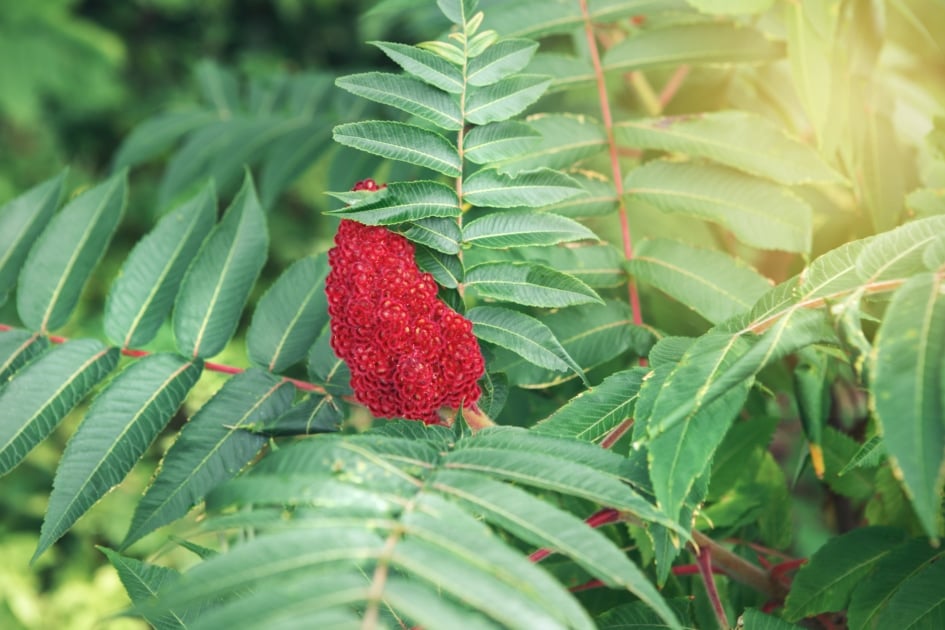
When most people hear the word “sumac,” they often associate it with the itchy relative of poison ivy. However, staghorn sumac is actually a completely different variety, and it is both edible and delicious! Here are some of the various ways people from around the world use it, along with some instructions for harvesting, drying, and incorporating it into a recipe.
Staghorn sumac, or Rhus typhina, is easily identified by the red fruit clusters resembling an Olympic torch, or the velvety antlers of a male deer (stag), hence the name of “staghorn.”
Sumac is widely popular in the Middle East and the Mediterranean regions. It is commonly used as a flavor enhancer and coloring agent in countries such as Israel, Turkey, and Italy. The dried and ground sumac berries have a unique tart taste, similar to lemons but less sour. Interestingly, before the arrival of lemons in Europe, the Romans relied on sumac berries to add a tangy flavor to their meals. These berries are also rich in vitamins A, C, and antioxidants
Even today, many Middle Eastern cultures prefer sumac over lemons or vinegar, keeping it readily available on their dining tables as a seasoning, just like how we use salt or pepp.
Sumac berries also have a long history of being used for medicinal purposes. Early pioneers used sumac to treat coughs, sore throats, fevers, and American Indians relied on these berries to address various health issues such as reproductive problems, stomach aches, and wounds
How to Harvest and Preserve Sumac
Harvesting your own sumac berries is simple. Staghorn sumac grows abundantly in the Great Plains and the eastern half of the United States. If you reside in the western half of the United States or cannot locate sumac nearby, cultivating your own is a straightforward process. These small trees are drought-tolerant, and they’ll handle a wide range of temperature zones.
To find sumac, search along the edges of woods, roadways, and areas that are not wooded but are not maintained. Staghorn sumac trees are relatively short, measuring between five and 15 feet tall, and their branches have 4 to 15 pairs of long, pointed leaves. The most notable feature is the clusters of bright red berries that adorn the trees during late summer and early fall.
Not Poison Sumac
Staghorn sumac should not be mistaken for poison sumac. To differentiate between the two, remember that poison sumac berries are white, while Staghorn sumac berries are red. Unfortunately, many Staghorn sumac plants have been wrongly removed due to the misconception that they are poisonous. However, it’s worth noting that poison sumac typically thrives in swampy areas. Therefore, if you stick to the dry areas that Staghorn sumac prefers, you won’t come across a poison sumac tree.
To harvest the berries, cut the clusters called “bobs” away from the trees. Roll a couple of the velvety berries between your fingers and give them a taste – you’ll experience their tartness! You can use the berries as they are or dry them for winter use. If you choose to dry them, use a dehydrator or heat lamps to dry the entire cluster overnight, as ovens usually can’t reach low enough temperatures (125º-150º). Once dry, use a blender to separate the dried berries from the seeds and sticks. Then, sift the sumac powder through a fine mesh strainer for future use.
Cooking with Sumac
Ground, dried sumac berries taste great as a spice rub for lamb, fish and chicken. These berries are also used as a salad topping, and you can include them in your favorite dressings. Middle Eastern chefs use sumac as a topping for fattoush salad, and are often sprinkled on hummus to add both color and a zesty flavor. In the United States, one of the most common ways to use sumac is to make red lemonade. Some even call it the “Lemonade Tree.” Give it a try!
Sumac Red Lemonade
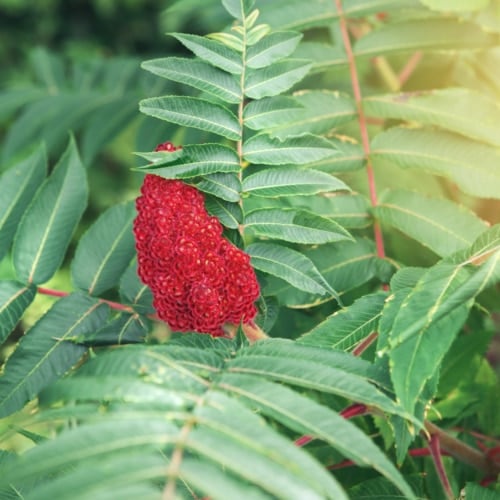
Sumac Red Lemonade
Ingredients
- 1 pint fresh sumac berries (about 6 to 8 clusters)
- 1/2 gallon cold water
- sugar to taste
Instructions
- Add the berries to the water and use a potato masher or a spoon to crush the berries so they release their flavor.
- Let the berries steep for 10 to 15 minutes.
- Once the sumac lemonade is flavored to your liking, pour it through a strainer or cheesecloth to remove the berries.
- Add enough sugar to sweeten the drink, but not so much that you lose the tangy flavor.
- Pour your sumac lemonade over ice and enjoy!
*Notes: You may want to avoid consuming Sumac that grows close to roadways because of its exposure to car fumes and toxins.

Amber Kanuckel
Amber Kanuckel is a freelance writer from rural Ohio who loves all things outdoors. She specializes in home, garden, environmental, and green living topics.

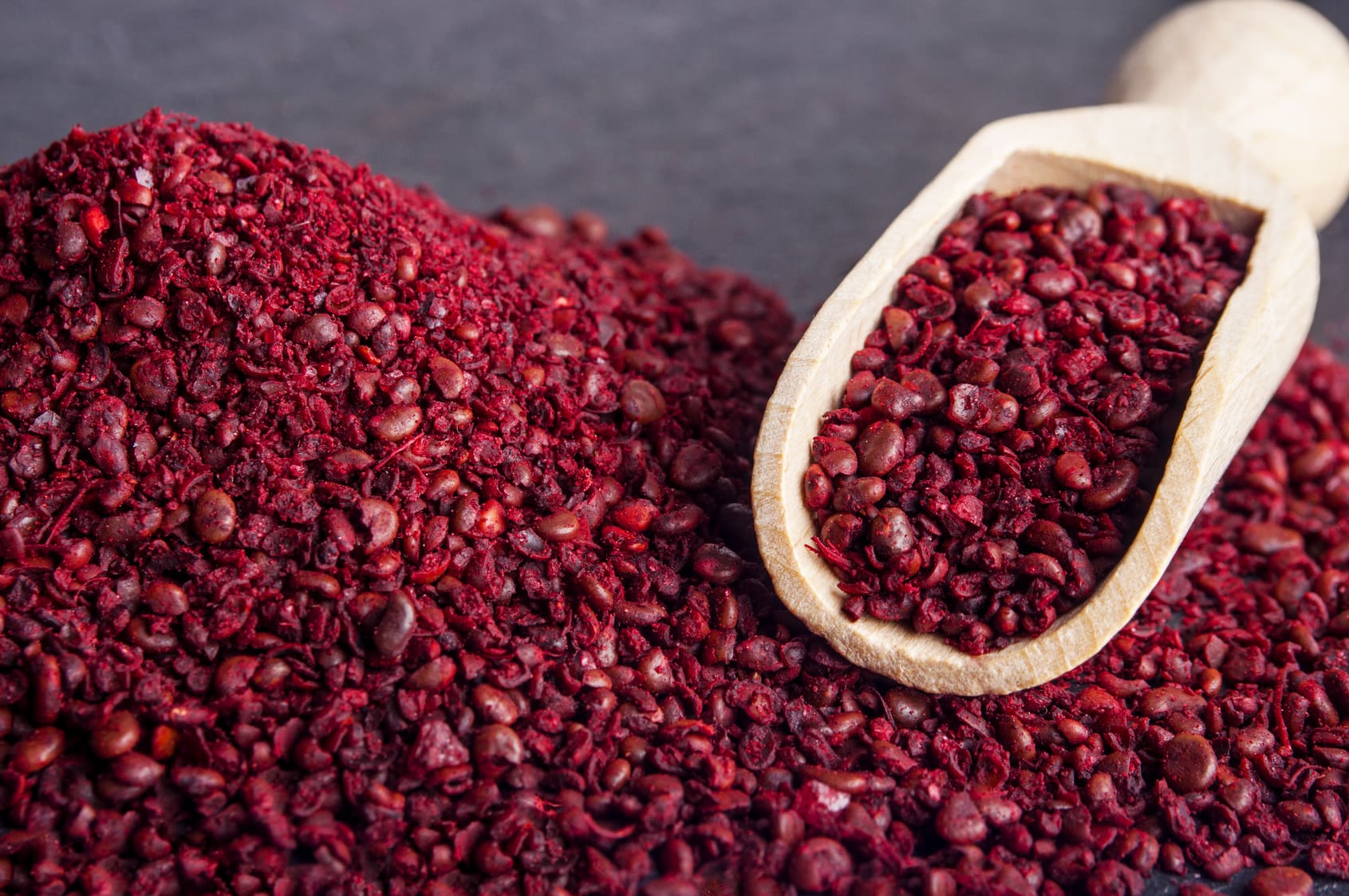

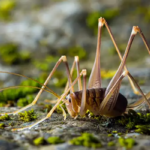

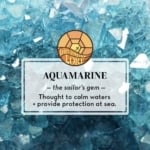

I have powdered sumac and want to make cough syrup how much do I use to make an 8 oz bottle
How do you store the lemonade once made?
I picked some last weekend and the outside berries are red but the interior of the cluster is brownish with what looks like little cobwebs and brownish berries. Are the red ones okay to use and discard the interior ones, or give the rest to my chickens or should I discard it all? I live in the lower South, zone 8.
I moved to the house I’m in a little over a year ago and kept wondering what these red berries were. I’ve got these sumac trees growing wild all over one side of my property. I grabbed one of these off the tree and tasted a berry. Definitely Sumac! My late husband was from Amman and we have always kept a large jar of this for fattoush salad or for sprinkling over roasted cauliflour (my favorite use). How exciting for me as the sumac I generally find at the Arabic store is not fresh. I’ll be harvesting and drying these for sure. Thanks for the information.
aw how nice. what a great little connection to your husband
I just bought a Staghorn Sumac tree online, I hope it will grow here in Southern Nevada , it’s a zone 8 tree so it should since it likes clay soil and tough areas. Just worried if it can take the heat?
I mostly got it for my chickens and local Quail, but I sure am going to try the lemonade.
I have several here in east alton Illinois about 20 miles north of st louis, they grow fantastic and are semi tropical. They thrive in the sun and hot weather. Mine are about 6 years old and about 10-15 feet tall with droopy branches. Mine also just ripened the berries so it’s time for tea! Also note these will pop up everywhere I mean 30- 40 at a time they root about ten inches deep and grow like crazy, they xan be contained by placing a thin metal ring about 6-8″ tall about 8-12″ down and about 3-4′ around the base. In winter all minor limbs will break off and all foliage s well but they always come back in the spring.
Sumac it’s an Arabic word سماق. The origin of this spice was from the Levantine area, Turkey and the rest of the Med took it with them to use in their dishes when they invaded the Middle East. It’s used in many delicious dishes and taste little sour and does not stain the hands or the mouth.
I LOVE sumac and bought some home in 2020 when I was in Amman. My question is, do you know if it can stain your hands and/or teeth and if so what to do about that. I noticed some black stains around my nails after cooking with sumac. Could be just coincidental but wondering if anyone has more experience than I do. thanks.
I never thought that Sumac berries are edible. Thanks for the article.
Just the red ones
We have smooth sumac in central Illinois. It provides beautiful leaves and some fruit. Is it OK to use?
Absolutley
I really enjoyed reading about sumac. Always heard they were poison. Thank you I will try them this summer..
Some Sumac are, stay clear if they have white berries